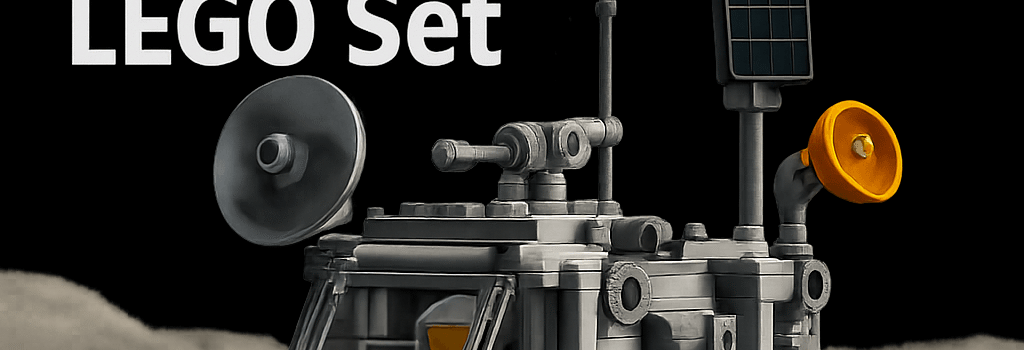Lunar Outpost Launches Advanced Moon Rover LEGO Set

In a landmark collaboration between private space robotics and toy manufacturing, Colorado-based Lunar Outpost and the Lego Group have unveiled the Lunar Outpost® Moon Rover Space Vehicle Lego Technic set. Inspired by Lunar Outpost’s Mobile Autonomous Prospecting Platform (MAPP), the 1,082-piece kit brings real lunar mobility hardware and in-situ resource utilization (ISRU) concepts to hobbyists and future engineers.
Lego x Lunar Outpost Partnership
This is Lego’s first collaboration with a commercial space company. According to Daniel Meehan, creative lead for space at the Lego Group, “For generations, we’ve empowered young minds with space sets that spark imagination. Partnering with Lunar Outpost builds upon that legacy by celebrating a new chapter in lunar exploration and robotics.”
From Full-Scale MAPP to Lego Technic Miniature
Real-World MAPP Rover Specifications
The real MAPP rover, deployed to the lunar south pole in March 2025 aboard a commercial lander, features:
- Mass & Dimensions: 12 kg dry mass, 0.6 m × 0.5 m × 0.4 m (length × width × height).
- Mobility: Four-wheel rocker-bogie suspension with independent steering, enabling ±30° wheel articulation over 30 cm obstacles.
- Power & Energy: Deployable solar arrays (25 W peak) coupled with a 100 Wh Li-ion battery pack, providing 6–8 hours of continuous operation.
- Sensors & Autonomy: Stereo navigation cameras, LIDAR rangefinder, IMU/GNSS payload for semi-autonomous traverse and hazard avoidance.
- ISRU Demonstrator: Sample collection turret with replaceable drill bits, onboard sieve and magnetic separation unit for regolith sorting experiments.
- Communications: S-band transceiver (1 Mb/s downlink, 256 kb/s uplink) with relay via lunar orbiter.
Technic Set Features and Building Experience
- 1,082 pieces: realistic gears, beams, panels, and electric motor modules.
- Functional rocker-bogie suspension and four-wheel steering.
- Deployable “solar panels” built from hinged panels for sun-tracking play.
- Rotating robotic arm with gripper and “crystal” resource elements.
- Miniature ISRU processing plant with conveyor belt and magnetic sorting station.
- Parent–child rover architecture: a larger main rover that deploys a smaller scouting vehicle.
Technical Deep Dive: MAPP Rover Design
The MAPP platform embodies modular robotics and scalable architectures. Andrew “AJ” Gemer, Lunar Outpost co-founder and CTO, explains: “Our design prioritizes multi-scale autonomy: a mother-daughter rover system where the main rover uses high-gain antennas and powerful processors, while the child rover scouts ahead with lightweight sensors and relays data back for path planning.” Key design elements include:
- Multi-Layer Control: Distributed ROS2 nodes for motor control, vision processing, and power management.
- Redundant Power: Dual-bus architecture isolates critical systems during charging cycles.
- In-Situ Resource Utilization: Prototype chemical reactors for regolith oxygen and water extraction, guided by NASA and JHU APL experimental payloads.
Future Missions and Collaboration
Lunar Outpost has >5 lunar surface missions booked through 2027. Highlights include:
- Australian Space Agency “Roo-ver” (launch Q3 2026): Australia’s first flagship lunar rover with specialized regolith compaction sensors.
- Magnetic Anomaly Investigation (spring 2026): Joint NASA–JHU APL payload to study a long-standing magnetic anomaly in the lunar South Pole–Aitken Basin.
- NASA Artemis LTV Competition: Lunar Outpost is one of three contenders to supply a crewed Lunar Terrain Vehicle for Artemis III (2027). The candidate LTV uses scaled-up rocker-bogie suspension, multi-hour RTG-hybrid power systems, and advanced human-robot interaction modules.
Educational Impact and STEM Outreach
“I bet most engineers started out as a kid playing with Lego,” says Gemer. “This set ties foundational STEM learning to real space exploration hardware.”
At Space Center Houston’s August “Astronaut Days,” families tested building challenges, coded simple robotics behaviors via a companion app, and won sets priced at $99.99. Lego’s investment in educational platforms—like the upcoming Lego Education Mindstorms lunar robotics curriculum—reinforces the connection between play and future space careers.
Conclusion
The Lunar Outpost® Moon Rover Space Vehicle set not only delivers an enriching building experience but also encapsulates the technical complexity of modern lunar robotics. As Lunar Outpost scales its real-world missions and Lego continues to innovate in STEM education, this partnership embodies the synergy between cutting-edge space technology and the inspiration of play.